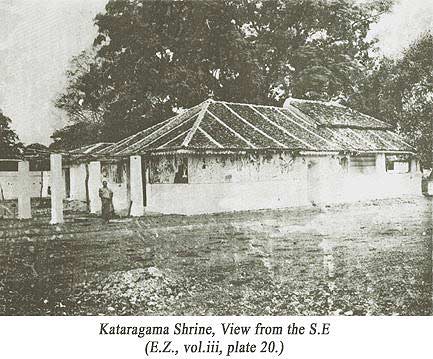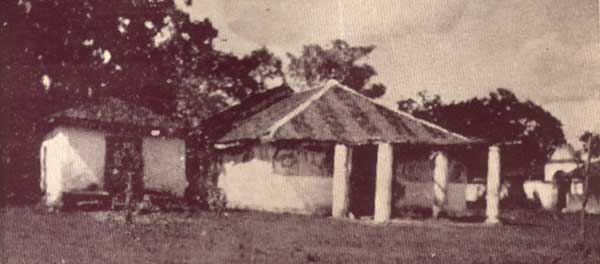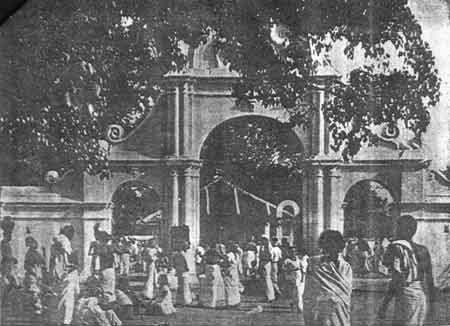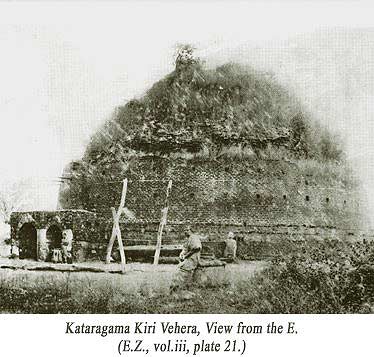|
| ||||||||||||
Kataragama Shrine: Its History and Epigraphyby Prof. Senarath Paranavithana
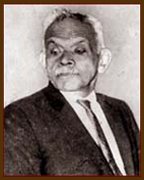
Kataragama is one of the most celebrated places of pilgrimage in Ceylon, sacred alike to the Buddhists as well as to the Hindus. To the former, it is one of the ‘sixteen great places’ at which the Buddha, during his third visit to the island, set is meditation. To the latter, it is the abode of Skanda, the youthful and fiery god of war. Kājaragāma, as the place is called in the Pāli writings, was one of the earliest settlement of the Sinhalese in this island. In the third century B.C., it was already the seat of a kşatriya clan whose representatives were among the distinguished personages assembled at Anurādhapura to pay homage to the branch of the sacred Bo tree brought to Ceylon by Sańghamittā, the daughter of the great Indian emperor Aśoka. One of the eight shoots which sprang up from this Bo tree was planted at Kataragama; and thus the place became a centre of the Buddhist faith [3] at very early date. The foundation of Mahāgāma, about ten miles to the south, by Mahānāga, brother of Devānampiya Tissa, seems to have eclipsed the fame of Kataragama; for, from that time up to the eleventh century, the place is mentioned but once in the Mahāvamsa. Dappula I, one of the best known of the rulers of Ruhuṇa, who had also a brief tenure of authority at Anurādhapura (642 A.D), is said to have founded a monastery at Kataragama.[4] In the first half of the eleventh century, Kataragama was, for a short period, of some moment in the affairs of the island. It was the last stronghold of the Sinhalese leaders of the time against the irresistible tide of Coḷa imperialism; and from there stared that movement which, after varying fortunes, resulted in the liberation of the island from the Coḷa yoke. Kataragama was, the scene of several hotly contested battles between the Sinhalese generals and the invading Coḷas on the one hand; and one of the other, of Kassapa the Kesadhātunāyaka against Kitti, the rising young hero who afterwards restored the sovereignty of the Sinhalese and ascended the throne of Poḷonnaruva as Vijayabāhu I. During these campaigns, the town was sacked by the invaders; and owing to this reason, as well as to the extension of Vijayabāhu’s activities to a wider sphere, the place seems to have sunk into comparative insignificance for it never again figures in the history of the island.[5] The shrine of the Kataragama god (see plate 20) which attracts such a large number of votaries annually from all parts of the island as well as from India, is a structure of modern origin [6]; and has no pretensions whatever to architectural beauty. It stands in the centre of a spacious enclosure within which there are also an old Bo tree supposed to be identical with the one planted during the reign of Devānampiya Tissa, a Buddhist image house of modern style and several minor shrines dedicated to the worship of Skanda’s wives and brother. An inscribed pillar (A.S.I. 490), of which more will be said in the sequel, stands in front of image house. A number of ancient stones are lying about the place; but these have all been brought here, a few years ago, from the grounds of the kirivehera. The dāgäba known as Kirivehera (see plate 21) about half a mile to the north of the devāle , is traditionally said to have been founded by Mahānāga (circa third century B.C). On some of the bricks fallen down from the dome, there are Brāhmi letters of about the first century B.C., inscribed as masons marks. And, as will be seen later, one of the inscriptions at the place records its enlargement in the first or second century A.D. Therefore, this stūpa may well be ascribed to a very early date, though we may not accept the tradition in its entirety. The monument itself is about the size of the Mirisaväṭiya dāg äba in Anurādhapura and stands on an artificially raised terrace, to which flights of steps lead on the four cardinal points. The harmmikā and the chatrāvalῑ have fallen down and the facing of the dome, too, is incomplete. Restoration work has recently been started and has now proceeded about half way up the dome. There are two inscriptions near this stūpa: one (A.S.I. 488) on a slab standing some 50 ft. to the south of the main entrance, and the other (A.S.I. 489) on a slab lying on the pavement now broken into four fragments of which one is missing.
This article first appeared in Epigraphia Zeylanica, Vol. III, page 212. (Oxford University Press, 1933) |
|
